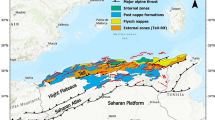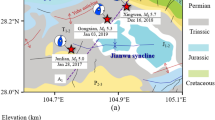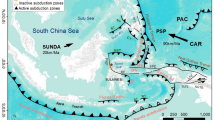Abstract
The 2016 magnitude (MW) 5.5 Gyeongju earthquake, which occurred in Korea near assumed epicenters of several substantial historical earthquakes and Quaternary fault segments, underscores the importance of seismic hazard assessment in the region. However, uncertainties about potential seismic sources make evaluating the potential for a moderate-to-large earthquake challenging. Microearthquake monitoring through a dense seismic network can provide crucial insights into the regional seismic characteristics. An extensive temporary seismic array known as the Gyeongju Hi-density Broadband Seismic Network (GHBSN) was established to investigate microearthquake activity in the southeastern Korean Peninsula. This included the zone of aftershocks from the 2016 Gyeongju earthquake sequence. The GHBSN comprises 200 broadband stations located at approximately 4.5 km intervals in an area of approximately 60 × 60 km2 around the epicenter of the mainshock. A total of 4,773 events were detected from November 2017 to December 2021, including 3,935 events within the GHBSN. The detected events were categorized into five seismic regions excluding quarry blasting sites, that is, the 2016 Gyeongju earthquake region, eastern part of the Ulsan Fault, 2017 Pohang earthquake region, eastern offshore Gyeongju, and western part of the Miryang Fault. A local magnitude scale was developed for the southeastern Korean Peninsula using events detected through the GHBSN. This reflects the distance attenuation and site conditions of the GHBSN stations for earthquakes. An event catalog was created using two automatic detection methods based on the measurement of the energy ratio. This provided high-resolution hypocenter parameters at a completeness magnitude (MC) of 0.0 despite the seismic environment of the network being exposed to high cultural noise. The Gutenberg-Richter b-value was estimated as 0.82 ± 0.02 for all events and 1.01 ± 0.02 for those inside GHBSN. This implies that the seismicity reflects a representative intraplate seismic environment. Testing the obtainability of the focal mechanism solutions showed that the GHBSN outperformed the regional network. Depending on the relationship between the magnitude and frequency of earthquakes, a relatively large number of small earthquakes can provide detailed information on the geometric properties of the causative faults and the state of the acting stress. High-precision microearthquake observation and analysis through GHBSN could provide an unprecedented opportunity with seismic datasets to understand the seismogenesis of the southeastern Korean Peninsula, including the zone of aftershocks of the 2016 Gyeongju earthquake.
Similar content being viewed by others
References
Ahern, T., Casey, R., Barnes, D., Benson, R., Knight, T., and Trabant, C., 2009, SEED reference manual, version 2.4. Incorporated Research Institutions for Seismology (IRIS), 220 p. https://www.fdsn.org/pdf/SEEDManual_V2.4.pdf [Accessed on 6 February 2024].
Allen, R.V., 1978, Automatic earthquake recognition and timing from single traces. Bulletin of the Seismological Society of America, 68, 1521–1532. https://doi.org/10.1785/BSSA0680051521
Baer, M. and Kradolfer, U., 1987, An automatic phase picker for local and teleseismic events. Bulletin of the Seismological Society of America, 77, 1437–1445. https://doi.org/10.1785/BSSA0770041437
Bender, B., 1983, Maximum likelihood estimation of b values for magnitude grouped data. Bulletin of the Seismological Society of America, 73, 831–851. https://doi.org/10.1785/BSSA0730030831
Bratt, S.R. and Bache, T.C., 1988, Locating events with a sparse network of regional arrays. Bulletin of the Seismological Society of America, 78, 780–798. https://doi.org/10.1785/BSSA0780020780
Chan, L. and Chandler, A., 2001, Spatial bias in b-value of the frequency-magnitude relation for the Hong Kong region. Journal of Asian Earth Sciences, 20, 73–81. https://doi.org/10.1016/S1367-9120(01)00025-6
Chang, C., Lee, J.B., and Kang, T.-S., 2010, Interaction between regional stress state and faults: complementary analysis of borehole in situ stress and earthquake focal mechanism in southeastern Korea. Tectonophysics, 485, 164–177. https://doi.org/10.1016/j.tecto.2009.12.012
Cheon, Y., Choi, J.-H., Choi, Y., Bae, H., Han, K.-H., Son, M., Choi, S.-J., and Ryoo, C.-R., 2020, Understanding the distribution and internal structure of the main core of the Yangsan Fault Zone: current trends and future work. Journal of the Geological Society of Korea, 56, 619–640. (in Korean with English abstract) https://doi.org/10.14770/jgsk.2020.56.5.619
Cheon, Y., Sin, Y.H., Park, S., Choi, J.-H., Kim, D.-E., Ko, K., Ryoo, C.-R., Kim, Y.-S., and Son, M., 2023, Structural architecture and late Cenozoic tectonic evolution of the Ulsan Fault Zone, SE Korea: new insights from integration of geological and geophysical data. Frontiers in Earth Science, 11, 1183329. https://doi.org/10.3389/feart.2023.1183329
Choi, H., Hong, T.-K., He, X., and Baag, C.-E., 2012, Seismic evidence for reverse activation of a paleo-rifting system in the East Sea (Sea of Japan). Tectonophysics, 572–573, 123–133. https://doi.org/10.1016/j.tecto.2011.12.023
Chough, S.K., Kwon, S.-T., Ree, J.-H., and Choi, D.K., 2000, Tectonic and sedimentary evolution of the Korean peninsula: a review and new view. Earth-Science Reviews, 52, 175–235. https://doi.org/10.1016/S0012-8252(00)00029-5
Chough, S.K. and Sohn, Y.K., 2010, Tectonic and sedimentary evolution of a Cretaceous continental arc-backarc system in the Korean peninsula: new view. Earth-Science Reviews, 101, 225–249. https://doi.org/10.1016/j.earscirev.2010.05.004
Chwae, U.C., Kim, K.B., Hong, S.H., Lee, B.J., Hwang, J.H., Park, K.H., Hwang, S.K., Choi, P.Y., Song, K.Y., and Jin, M.S., 1995, Geological map of Korean (Scale 1:1,000,000). Korea Institute of Geology, Mining and Materials, Daejeon, South Korea.
Grigoli, F., Cesca, S., Rinaldi, A.P., Manconi, A., López-Comino, J.A., Clinton, J.F., Westaway, R., Cauzzi, C., Dahm, T., and Wiemer, S., 2018a, The November 2017 Mw 5.5 Pohang earthquake: a possible case of induced seismicity in South Korea. Science, 360, 1003–1006. https://doi.org/10.1126/science.aat2010
Grigoli, F., Scarabello, L., Böse, M., Weber, B., Wiemer, S., and Clinton, J.F., 2018b, Pick-and waveform-based techniques for real-time detection of induced seismicity. Geophysical Journal International, 213, 868–884. https://doi.org/10.1093/gji/ggy019
Han, M., Kim, K.-H., Son, M., and Kang, S.Y., 2017, Current microseismicity and generating faults in the Gyeongju area, southeastern Korea. Tectonophysics, 694, 414–423. https://doi.org/10.1016/j.tecto.2016.11.026
Helmholtz-Centre Potsdam - GFZ German Research Centre for Geosciences and GEMPA GmbH, 2008, The SeisComP seismological software package. GFZ Data Services. https://doi.org/10.5880/GFZ.2.4.2020.003
Hong, T.-K., Lee, J., Kim, W., Hahm, I.-K., Woo, N.C., and Park, S., 2017, The 12 September 2016 ML 5.8 midcrustal earthquake in the Korean Peninsula and its seismic implications. Geophysical Research Letters, 44, 3131–3138. https://doi.org/10.1002/2017GL072899
Hong, T.-K., Park, S., Lee, J., and Kim, W., 2020, Spatiotemporal seismicity evolution and seismic hazard potentials in the western East Sea (Sea of Japan). Pure and Applied Geophysics, 177, 3761–3774. https://doi.org/10.1007/s00024-020-02479-z
Huang, J. and Turcotte, D.L., 1988, Fractal distributions of stress and strength and variations of b-value. Earth and Planetary Science Letters, 91, 223–230. https://doi.org/10.1016/0012-821X(88)90164-1
Hutton, L.K. and Boore, D.M., 1987, The ML scale in southern California. Bulletin of the Seismological Society of America, 77, 2074–2094. https://doi.org/10.1785/BSSA0770062074
Hwang, B.-H., Lee, J.-D., and Yang, K., 2004, Petrological study of the granitic rocks around the Yangsan Fault: lateral displacement of the Yangsan Fault. Journal of the Geological Society of Korea, 40, 161–178. (in Korean with English abstract)
Hwang, J.H., Jin, M.S., Jun, M.-S., Cho, J.D., Lee, S., Koo, S.B., Choi, P.-Y., Lee, Y.S., Kim, B.C., Kim, J.W., Kee, W.-S., Kang, P.C., Song, K.Y., Kim, J.H., Lee, S.R., and Chang, T.W., 2001, Tectonic Map of Korea (Scale 1:1,000,000). Korea Institute of Geoscience and Mineral Resources, Daejeon, South Korea.
Jolivet, L., Tamaki, K., and Fournier, M., 1994, Japan Sea, opening history and mechanism: a synthesis. Journal of Geophysical Research: Solid Earth, 99, 22237–22259. https://doi.org/10.1029/93JB03463
Jun, M.-S., 1990, Source parameters of shallow intraplate earthquakes in and around the Korean Peninsula and their tectonic implication. Ph.D. Thesis, Uppsala University, Uppsala, Sweden, 142 p.
Jun, M.-S. and Jeon, J.-S., 2010, Focal mechanism in and around the Korean Peninsula. Geophysics and Geophysical Exploration, 13, 198–202. (in Korean with English abstract)
Kang, T.-S. and Shin, J.S., 2006, Surface-wave tomography from ambient seismic noise of accelerograph networks in southern Korea. Geophysical Research Letters, 33, L17303. https://doi.org/10.1029/2006GL027044
Kavoura F., Savvaidis, A., and Rathje, E., 2020, Determination of local magnitude for earthquakes recorded from the Texas Seismological Network (TexNet). Seismological Society of America, 91, 3223–3235. https://doi.org/10.1785/0220190366
Kim, K.-H., Kang, T.-S., Rhie, J., Kim, Y., Park, Y., Kang, S.Y., Han, M., Kim, J., Park, J., Kim, M., Kong, C., Heo, D., Lee, H., Park, E., Park, H., Lee, S.-J., Cho, S., Woo, J.-U., Lee, S.-H., and Kim, J., 2016a, The 12 September 2016 Gyeongju earthquakes: 2. Temporary seismic network for monitoring aftershocks. Geosciences Journal, 20, 753–757. https://doi.org/10.1007/s12303-016-0034-9
Kim, K.-H., Kim, J., Han, M., Kang, S.Y., Son, M., Kang, T.-S., Rhie, J., Kim, Y., Park, Y., Kim, H.-J., You, Q., and Hao, T., 2018a, Deep fault plane revealed by high-precision locations of early aftershocks following the 12 September 2016 ML 5.8 Gyeongju, Korea, earthquake. Bulletin of the Seismological Society of America, 108, 517–523. https://doi.org/10.1785/0120170104
Kim, K.-H., Ree, J.-H., Kim, Y., Kim, S., Kang, S.Y., and Seo, W., 2018b, Assessing whether the 2017 MW 5.4 Pohang earthquake in South Korea was an induced event. Science, 360, 1007–1009. https://doi.org/10.1126/science.aat6081
Kim, M., Kang, T.-S., Yoo, H.J., Rhie, J., Kim, Y., Kim, K.-H., and Park, Y., 2018c, Development of an automatic analysis algorithm for dense temporary seismic network and its application to the 2016 ML 5.8 Gyeongju earthquake sequence, Korea. 2018 American Geophysical Union Fall Meeting, Washington, D.C., USA, Dec. 10–14, Abstract #S33E-0643.
Kim, S., Rhie, J., and Kim, G., 2011, Forward waveform modelling procedure for 1-D crustal velocity structure and its application to the southern Korean Peninsula. Geophysical Journal International, 185, 453–468. https://doi.org/10.1111/j.1365-246X.2011.04949.x
Kim, S.-K., Jun, M.-S., and Jeon, J.-S., 2006a, Recent research for the seismic activities and crustal velocity structure. Economic and Environmental Geology, 39, 369–384. (in Korean with English abstract)
Kim, W.-Y., Noh, M.-H., and Choi, H.-S., 2006b, The 29 May 2004 offshore southeast coast of Korea earthquake sequence: shallow earthquakes in the Ulleung back-arc basin, East Sea (Sea of Japan). Journal of the Korean Geophysical Society, 9, 249–262.
Kim, Y., He, X., Ni, S., Lim, H., and Park, S.-C., 2017, Earthquake source mechanism and rupture directivity of the 12 September 2016 Mw 5.5 Gyeongju, South Korea, earthquake. Bulletin of the Seismological Society of America, 107, 2525–2531. https://doi.org/10.1785/0120170004
Kim, Y., Rhie, J., Kang, T.-S., Kim, K.-H., Kim, M., and Lee, S.-J., 2016b, The 12 September 2016 Gyeongju earthquakes: 1. Observation and remaining questions. Geosciences Journal, 20, 747–752. https://doi.org/10.1007/s12303-016-0033-x
Korea Meteorological Administration, 2021, 2020 annual quality analysis report of seismic data. Korea Meteorological Administration, Seoul, South Korea, 514 p. (in Korean)
Korrat, I.M., Lethy, A., ElGabry, M.N., Hussein, H.M., and Othman, A.S., 2022, Discrimination between small earthquakes and quarry blasts in Egypt using spectral source characteristics. Pure and Applied Geophysics, 179, 599–618. https://doi.org/10.1007/s00024-022-02953-w
Kyung, J.B., 2003, Paleoseismology of the Yangsan fault, southeastern part of the Korean Peninsula. Annals of Geophysics. 46, 983–996. https://doi.org/10.4401/ag-3465
Kyung, J.B. and Chang, T.W., 2001, The latest fault movement on the northern Yangsan fault zone around the Yugye-ri area, southeast Korea. Journal of the Geological Society of Korea, 37, 563–577. (in Korean with English abstract)
Kyung, J.B. and Lee, K., 2006, Active fault study of the Yangsan fault system and Ulsan fault system, southeastern part of the Korean Peninsula. Journal of the Korean Geophysical Society, 9, 219–230.
Lahr, J.C., 1999, revised 2012, HYPOELLIPSE: a computer program for determining local earthquake hypocentral parameters, magnitude, and first motion pattern. USGS Open-File Report 99-23, version 1.1, U.S. Geological Survey, Reston, USA, 119 p.
Lee, K. and Jin, Y.G., 1991, Segmentation of the Yangsan fault system: geophysical studies on major faults in the Kyeongsang basin. Journal of the Geological Society of Korea, 27, 434–449.
Lee, K. and Yang, W.-S., 2006, Historical seismicity of Korea. Bulletin of the Seismological Society of America, 96, 846–855. https://doi.org/10.1785/0120050050
Lee, K.-K., Ellsworth, W.L., Giardini, D., Townend, J., Ge, S., Shimamoto, T., Yeo, I.-W., Kang, T.-S., Rhie, J., Sheen, D.-H., Chang, C., Woo, J.-U., and Langenbruch, C., 2019, Managing injection-induced seismic risks. Science, 364, 730–732. https://doi.org/10.1126/science.aax1878
Lim, H., Deng, K., Kim, Y.H., Ree, J.-H., Song, T.-R.A., and Kim, K.-H., 2020, The 2017 Mw 5.5 Pohang earthquake, South Korea, and poroelastic stress changes associated with fluid injection. Journal of Geophysical Research: Solid Earth, 125, e2019JB019134. https://doi.org/10.1029/2019JB019134
Lim, H., Kim, Y., Kwon, K.B., Han, J., Ahn, B.S., Chai, G., Choi, Y., Heo, D., Jung, Y., Kang, H., Koh, M.H., Kwon, J., Park, J.Y., Seo, M.-S., Son, Y.O., Han, S., Kang, T.-S., Rhie, J., Kim, K.-H., and Ree, J.-H., 2021, Deployment of the linear array with geophones on the fault zone of the 2016 Mw 5.5 Gyeongju earthquake. Journal of the Geological Society of Korea, 57, 741–746. https://doi.org/10.14770/jgsk.2021.57.5.741
Maeda, N., 1985, A method for reading and checking phase times in autoprocessing system of seismic wave data. Zisin, 38, 365–379. (in Japanese with English abstract) https://doi.org/10.4294/zisin1948.38.3_365
McNamara, D.E. and Buland, R.P., 2004, Ambient noise levels in the continental United States. Bulletin of the Seismological Society of America, 94, 1517–1527. https://doi.org/10.1785/012003001
Miao, Q. and Langston, C.A., 2007, Empirical distance attenuation and the local-magnitude scale for the central United States. Bulletin of the Seismological Society of America, 97, 2137–2151. https://doi.org/10.1785/0120060188
Molnar, P. and Tapponnier, P., 1975, Cenozoic tectonics of Asia: effects of a continental collision. Science, 189, 419–426.
Noh, M., 2019, Assessment of the completeness of earthquake catalogs. Geosciences Journal, 23, 253–263. https://doi.org/10.1007/s12303-018-0028-x
Okal, E.A. and Sweet, J.R., 2007, Frequency-size distributions for intraplate earthquakes. In: Stein, S. and Mazzotti, S. (eds.), Continental Intraplate Earthquakes: Science, Hazard, and Policy Issues. Geological Society of America, Special Papers, 425, p. 59–71. https://doi.org/10.1130/2007.2425(05)
Park, Y., Ree, J.-H., and Yoo, S.-H., 2006, Fault slip analysis of Quaternary faults in southeastern Korea. Gondwana Research, 9, 118–125. https://doi.org/10.1016/j.gr.2005.06.007
Peterson, J., 1993, Observations and modeling of seismic background noise. USGS Open-File Report 93-322, U.S. Geological Survey, Reston, USA, 95 p. https://doi.org/10.3133/ofr93322
Ree, J.-H., Lee, Y.-J., Rhodes, E.J., Park, Y., Kwon, S.-T., Chwae, U., Jeon, J.-S., and Lee, B., 2003, Quaternary reactivation of Tertiary faults in the southeastern Korean Peninsula: age constraint by optically stimulated luminescence dating. Island Arc, 12, 1–12. https://doi.org/10.1046/j.1440-1738.2003.00372.x
Richter, C.F., 1935, An instrumental earthquake magnitude scale. Bulletin of the Seismological Society of America, 25, 1–32. https://doi.org/10.1785/BSSA0250010001
Schorlemmer, D., Wiemer, S., and Wyss, M., 2005, Variations in earthquake-size distribution across different stress regimes. Nature, 437, 539–542. https://doi.org/10.1038/nature04094
Seo, M.-S., Son, Y.O., Kim, Y., Kang, T.-S., Rhie, J., Kim, K.-H., and Ree, J.-H., 2022, Measurement of seismometer misorientation based on P-wave polarization: application to dense temporary broadband seismic array in the epicentral region of 2016 Gyeongju earthquake, South Korea. Geosciences Journal, 26, 385–397. https://doi.org/10.1007/s12303-021-0041-3
Sheen, D.-H., Kang, T.-S., and Rhie, J., 2018, A local magnitude scale for South Korea. Bulletin of the Seismological Society of America, 108, 2748–2755. https://doi.org/10.1785/0120180112
Shi, Y. and Bolt, B.A., 1982, The standard error of the magnitude-frequency b value. Bulletin of the Seismological Society of America, 72, 1677–1687. https://doi.org/10.1785/BSSA0720051677
Snoke, J.A., 2003, FOCMEC: focal mechanism determinations. In: Lee, W.H.K., Kanamori, H., Jennings, P.C., and Kisslinger, C. (eds.), International Handbook of Earthquake and Engineering Seismology. International Geophysics Book Series, Academic Press, 81, p. 1629–1630. https://doi.org/10.1016/S0074-6142(03)80291-7
Son, M., Cho, C.S., Shin, J.S., Rhee, H.-M., and Sheen, D.-H., 2018, Spatiotemporal distribution of events during the first three months of the 2016 Gyeongju, Korea, earthquake sequence. Bulletin of the Seismological Society of America, 108, 210–217. https://doi.org/10.1785/0120170107
Talwani, P., 2017, On the nature of intraplate earthquakes. Journal of Seismology, 21, 47–68. https://doi.org/10.1007/s10950-016-9582-8
Uchide, T. and Song, S.G., 2018, Fault rupture model of the 2016 Gyeongju, South Korea, earthquake and its implication for the underground fault system. Geophysical Research Letters, 45, 2257–2264. https://doi.org/10.1002/2017GL076960
Uhrhammer, R.A. and Collins, E.R., 1990, Synthesis of Wood-Anderson seismograms from broadband digital records. Bulletin of the Seismological Society of America, 80, 702–716. https://doi.org/10.1785/BSSA0800030702
Wadati, K. and Oki, S., 1933, On the travel time of earthquake waves (Part II). Journal of the Meteorological Society of Japan, Series II, 11, 14–28. (in Japanese with English abstract) https://doi.org/10.2151/jmsj1923.11.1_14
Waldhauser, F. and Ellsworth, W.L., 2000, A double-difference earthquake location algorithm: method and application to the northern Hayward Fault, California. Bulletin of the Seismological Society of America, 90, 1353–1368. https://doi.org/10.1785/0120000006
Wiemer, S. and Wyss, M., 2000, Minimum magnitude of completeness in earthquake catalogs: examples from Alaska, the western United States, and Japan. Bulletin of the Seismological Society of America, 90, 859–869. https://doi.org/10.1785/0119990114
Woo, J.-U., Kim, M., Rhie, J., and Kang, T.-S., 2020, Aftershock sequence and statistics of the 2017 Mw 5.5 Pohang, South Korea, earthquake: implications of fault heterogeneity and postseismic relaxation. Bulletin of the Seismological Society of America, 110, 2031–2046. https://doi.org/10.1785/0120200059
Woo, J.-U., Kim, M., Sheen, D.-H., Kang, T.-S., Rhie, J., Grigoli, F., Ellsworth, WL., and Giardini, D., 2019a, An in-depth seismological analysis revealing a causal link between the 2017 MW 5.5 Pohang earthquake and EGS project. Journal of Geophysical Research: Solid Earth, 124, 13060–13078. https://doi.org/10.1029/2019JB018368
Woo, J.-U., Rhie, J., Kim, S., Kang, T.-S., Kim, K.-H., and Kim, Y., 2019b, The 2016 Gyeongju earthquake sequence revisited: aftershock interactions within a complex fault system. Geophysical Journal International, 217, 58–74. https://doi.org/10.1093/gji/ggz009
Acknowledgments
This study was supported by the Nuclear Safety Research Program through the Korea Foundation of Nuclear Safety (KoFONS), using financial resources granted by the Nuclear Safety and Security Commission (NSSC) of the Republic of Korea (No. 1705010, 2203023). The authors thank Associate Editor Tae-Kyung Hong and the two reviewers for their valuable comments, which helped improve our manuscript.
Author information
Authors and Affiliations
Corresponding author
Additional information
Publisher’s Note Springer Nature remains neutral with regard to jurisdictional claims in published maps and institutional affiliations.
Electronic Supplementary Material
Rights and permissions
About this article
Cite this article
Heo, D., Kang, TS., Kim, M. et al. New insights on seismic activity in the southeastern Korean Peninsula from the Gyeongju Hi-density Broadband Seismic Network (GHBSN). Geosci J (2024). https://doi.org/10.1007/s12303-024-0003-7
Received:
Accepted:
Published:
DOI: https://doi.org/10.1007/s12303-024-0003-7




